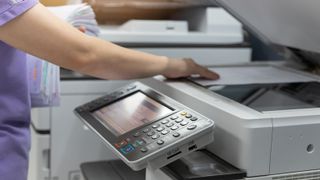How do laser printers work?
If you’re scratching your head wondering how laser printers work, then we’ve got all the answers here

After watching too many sci-fi films, the last place you might expect to encounter lasers is in a simple piece of office equipment: the printer. There’s no need to worry, as this doesn’t mean your reliable piece of hardware is going to start blasting red flashes of light at you anytime soon.
Instead, lasers are used in an intricate process which ends up with a piece of paper with exactly what you wanted printed on it. For users, all you do is hit print and send your document or image to be printed. However, once you know what goes on in the belly of your beast, the laser printing process is actually very interesting.
If you’re trying to work out which kind of printer is the best for you, you’re simply curious about how these devices function, or you’re trying to see which is best for the workplace or your small business, simply read on to find out how this piece of equipment works.
How laser printers work
Laser printers use a heated wire to positively charge a drum. Then, a laser passes over it which reverses the charge in the parts that it covers. You end up with a negatively charged area of the drum which becomes the text or image that needs to be printed.
A toner roller is passed over the drum, causing toner particles to stick to the areas which are negatively charged. Toner is made up of microscopic ink particles which will stick to these negatively charged areas of the drum.
Then, a sheet of paper is slotted underneath the toner-coated drum which spreads the toner onto its surface. This ends up creating a printer copy of the digital image or document that a user sent to be printed.
If that’s too much to take in, we’ve summarised the process below:
Get the ITPro. daily newsletter
Receive our latest news, industry updates, featured resources and more. Sign up today to receive our FREE report on AI cyber crime & security - newly updated for 2024.
- The printer needs to warm up and reached a specific temperature in order to heat the wire
- The wire is heated and passes an electrical charge to the drum unit. This causes the drum unit to be positively charged
- The laser is activated, beamed to various mirrors and reflected across the drum’s surface. Where it hits the drum, the positive charge changes to negative. This creates an outline of what you’re printing
- The negatively charged areas are where the toner particles stick to the drum to then be transferred onto paper
- An ink roller coats the drum with toner which begins sticking to the drum
- Paper passes near the drum, causing the negatively charged toner particles to be attracted onto the page
- The particles are then fused to the paper and the page is spat out of the printer
Do laser printers use ink?
Unlike inkjet printers, laser printers don’t use traditional ink. Instead they tend to use toner which is a fine, dry powder. It’s essentially a mixture of plastic, carbon, or polyester particles, combined with colouring agents, which comes in cylinders. Thanks to the fact that it’s powder based, it’s normally cheap to ship, store, and use.
Are laser printers faster at printing?
Since lasers can move extremely quickly, they’re usually faster at moving than an inkjet printer. The laser beam is also able to draw more precisely without spilling excess ink. Although these devices might be more expensive than inkjets, it usually costs less to fuel them since toner powder is cheaper and lasts longer too.
Zach Marzouk is a former ITPro, CloudPro, and ChannelPro staff writer, covering topics like security, privacy, worker rights, and startups, primarily in the Asia Pacific and the US regions. Zach joined ITPro in 2017 where he was introduced to the world of B2B technology as a junior staff writer, before he returned to Argentina in 2018, working in communications and as a copywriter. In 2021, he made his way back to ITPro as a staff writer during the pandemic, before joining the world of freelance in 2022.





